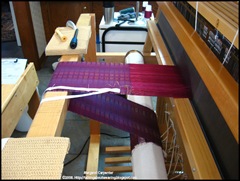Posted by Peg in South Carolina
Here is a photo which shows where I am keeping the fell line during  weaving. It is probably closer to the reed than many weavers would normally weave. But in the case of this warp it is working fine.
weaving. It is probably closer to the reed than many weavers would normally weave. But in the case of this warp it is working fine.
WHY I WOVE CLOSE TO THE BREAST BEAM
I now remember why I was weaving with the fell as close to the front beam as possible. Because the angle formed by the warp ends is not so extreme there, opening the sheds is easier on the warp. The closer you get to the beater, the more strength is required of the warp when the shed is opened, especially if you weave on a highly tensioned warp as I do. Silk, however, especially if tightly spun, is incredibly strong and will take the tension.
MOVING THE FABRIC AS YOU WEAVE
Wherever you decide to keep the fell when weaving, it is important to move the fabric every inch or two. Doing this keeps the fell in the same position throughout the weaving. In an earlier post I had mentioned Osterkamp’s discussion of how the ability of the beater to pack in the weft grows stronger as the fell approaches the front beam. If you want a consistent beat, then, it is important to keep the fell in the same or nearly the same position all the time you weave.
A BEGINNING WEAVER’S FEAR
When I was a new weaver I wove each small section for as long as I possibly could. I wove with the fell starting as close to the front beam as possible and continued weaving until I simply could not get the shuttle through a decent shed. Why? Ignorance for one thing! Fear for the other!
I did know what would happen if I didn’t maintain the same tension throughout; I did know that the beat was likely to change. I didn’t understand why. But I had seen baby blankets woven where even from a distance it was clear the beat had changed from beginning to end. No measuring and counting was necessary in order to see this. So I was afraid that I would not be able to get the same tension back after I moved the warp. Consequently I thought the less I had to move the warp, the less danger there was for this. Logical, huh?!
Related Posts:
Practice
Learning the Hard Way
"Where is my Fell?" was written by Margaret Carpenter for Talking about Weaving and was originally posted on September 24, 2008. © 2008 Margaret Carpenter aka Peg in South Carolina



4 comments:
Good morning, Miss Peg!
Oh, I can so relate (as can many of us, I'm sure). You stated exactly what I used to feel in my earlier weaving days. I used to squ e e e ze every inch out of my warp before advancing it. I was so nervous about maintaining tension *and* I just hated interrupting my weaving rhythm by stopping, winding, starting, etc.
Then, I became more aware of how much nicer my fabric was when I advanced the warp every few inches and kept the fell line within the same "band" of area. Now, it's second nature to stop, advance, adjust, weave, repeat. But boy, it was a major step to get me there, I confess! (oh, and I'd be lying if I said that on occasion, I don't *still* push my fell line further than I ought -- usually when I know I'm about to run out of weft on my shuttle and want to do all of my "stopping" at one time to reload the shuttle, advance the warp, etc.)
Yours in fell watching,
Jane
Hi Peg, I've been learning about this too.
Besides getting better fabric, I think it's good to get up and move the warp after every couple of inches because I think it's good to move about, get rid of any tension in my shoulders (I tense up there when I'm concentrating) and also it's a chance to think about how the weaving is going.
I'm working in the range of about 5.5" - 7" from the breast beam.
Not only a major step, Jane, but lots and lots of practice. Right now the possibility of "cheating" is quite limited since I am weaving relatively close to the beater.
Dorothy, I agree about getting up from time to time. Actually, I find that as I weave, I get up more and more frequently until I realize it is just plain time to stop.
There are some things that only experience can teach. I think this is one of them. The exciting part is that there is always fine tuning to be done! Well, sometimes it's exciting, sometimes it's frustrating. :)
Post a Comment